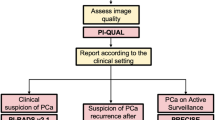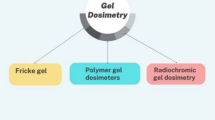Abstract
A few reports have discussed the influence of inter-fractional position error and intra-fractional motion on dose distribution, particularly regarding a spread-out Bragg peak. We investigated inter-fractional and intra-fractional prostate position error by monitoring fiducial marker positions. In 2020, data from 15 patients with prostate cancer who received carbon-ion beam radiotherapy (CIRT) with gold markers were investigated. We checked marker positions before and during irradiation to calculate the inter-fractional positioning and intra-fractional movement and evaluated the CIRT dose distribution by adjusting the planning beam isocenter and clinical target volume (CTV) position. We compared the CTV dose coverages (CTV receiving 95% [V95%] or 98% [V98%] of the prescribed dose) between skeletal and fiducial matching irradiation on the treatment planning system. For inter-fractional error, the mean distance between the marker position in the planning images and that in a patient starting irradiation with skeletal matching was 1.49 ± 1.11 mm (95th percentile = 1.85 mm). The 95th percentile (maximum) values of the intra-fractional movement were 0.79 mm (2.31 mm), 1.17 mm (2.48 mm), 1.88 mm (4.01 mm), 1.23 mm (3.00 mm), and 2.09 mm (8.46 mm) along the lateral, inferior, superior, dorsal, and ventral axes, respectively. The mean V95% and V98% were 98.2% and 96.2% for the skeletal matching plan and 99.5% and 96.8% for the fiducial matching plan, respectively. Fiducial matching irradiation improved the CTV dose coverage compared with skeletal matching irradiation for CIRT for prostate cancer.







Similar content being viewed by others
Data availability
The data that support the findings of this study are available on request from the corresponding author but restrictions apply to the availability of these data, which are not publicly available due to ethical restrictions.
References
Ishikawa H, Tsuji H, Kamada T, Yanagi T, Mizoe J-E, Kanai T, Morita S, Wakatsuki M, Shimazaki J, Tsujii H, Working Group for Genitourinary T. Carbon ion radiation therapy for prostate cancer results of a prospective phase II study Radiotherapy and oncology. J Euro Soc Ther Radiol Oncol. 2006;81(1):57–64.
Ishikawa H, Tsuji H, Kamada T, Akakura K, Suzuki H, Shimazaki J, Tsujii H, Working Group for Genitourinary T. Carbon-ion radiation therapy for prostate cancer. Int J Urol. 2012;19(4):296–305.
Sato H, Kasuya G, Ishikawa H, Nomoto A, Ono T, Nakajima M, Isozaki Y, Yamamoto N, Iwai Y, Nemoto K, Ichikawa T, Tsuji H, Working Group for Genitourinary T. Long-term clinical outcomes after 12-fractionated carbon-ion radiotherapy for localized prostate cancer. Cancer Sci. 2021;112(9):3598–606.
Kamada T, Tsujii H, Blakely EA, Debus J, De Neve W, Durante M, Jakel O, Mayer R, Orecchia R, Potter R, Vatnitsky S, Chu WT. Carbon ion radiotherapy in Japan: an assessment of 20 years of clinical experience. Lancet Oncol. 2015;16(2):e93–100.
Crook JM, Raymond Y, Salhani D, Yang H, Esche B. Prostate motion during standard radiotherapy as assessed by fiducial markers. Radiother Oncol. 1995;37(1):35–42.
Schallenkamp JM, Herman MG, Kruse JJ, Pisansky TM. Prostate position relative to pelvic bony anatomy based on intraprostatic gold markers and electronic portal imaging. Int J Radiat Oncol Biol Phys. 2005;63(3):800–11.
Higuchi D, Ono T, Kakino R, Aizawa R, Nakayasu N, Ito H, Sakamoto T. Evaluation of internal margins for prostate for step and shoot intensity-modulated radiation therapy and volumetric modulated arc therapy using different margin formulas. J Appl Clin Med Phys. 2022;23(9):e13707.
Shirato H, Harada T, Harabayashi T, Hida K, Endo H, Kitamura K, Onimaru R, Yamazaki K, Kurauchi N, Shimizu T, Shinohara N, Matsushita M, Dosaka-Akita H, Miyasaka K. Feasibility of insertion/implantation of 2 0-mm-diameter gold internal fiducial markers for precise setup and real-time tumor tracking in radiotherapy. Int J Radiat Oncol Biol Phys. 2003;56(1):240–7.
Kok D, Gill S, Bressel M, Byrne K, Kron T, Fox C, Duchesne G, Tai KH, Foroudi F. Late toxicity and biochemical control in 554 prostate cancer patients treated with and without dose escalated image guided radiotherapy. Radiother Oncol. 2013;107(2):140–6.
Sveistrup J, Rosenschold PM, Deasy JO, Oh JH, Pommer T, Petersen PM, Engelholm SA. Improvement in toxicity in high risk prostate cancer patients treated with image-guided intensity-modulated radiotherapy compared to 3D conformal radiotherapy without daily image guidance. Radiat Oncol. 2014;9:44.
Engels B, Soete G, Verellen D, Storme G. Conformal arc radiotherapy for prostate cancer: increased biochemical failure in patients with distended rectum on the planning computed tomogram despite image guidance by implanted markers. Int J Radiat Oncol Biol Phys. 2009;74(2):388–91.
Tsubouchi T, Hamatani N, Takashina M, Wakisaka Y, Ogawa A, Yagi M, Terasawa A, Shimazaki K, Chatani M, Mizoe J, Kanai T. Carbon ion radiotherapy using fiducial markers for prostate cancer in Osaka HIMAK: treatment planning. J Appl Clin Med Phys. 2021;22(9):242–51.
Mori S, Shirai T, Takei Y, Furukawa T, Inaniwa T, Matsuzaki Y, Kumagai M, Murakami T, Noda K. Patient handling system for carbon ion beam scanning therapy. J Appl Clin Med Phys. 2012;13(6):3926.
Mori S, Kumagai M, Miki K, Fukuhara R, Haneishi H. Development of fast patient position verification software using 2D–3D image registration and its clinical experience. J Radiat Res. 2015;56(5):818–29.
International Electrotechnical Commission, Radiotherapy Equipment - Coordinates, Movements and Scales. Pub IEC. 2002;61217.
Hirai R, Watanabe W, Sakata Y, Tanizawa A, Mori S. Real-time linear fiducial marker tracking in respiratory-gated radiotherapy for hepatocellular carcinoma. Int J Radiat Oncol Biol Phys. 2019;105(1):E750–1.
Fukahori M, Matsufuji N, Himukai T, Kanematsu N, Mizuno H, Fukumura A, Tsuji H, Kamada T. Estimation of late rectal normal tissue complication probability parameters in carbon ion therapy for prostate cancer. Radiother Oncol. 2015.
Takakusagi Y, Katoh H, Kano K, Anno W, Tsuchida K, Mizoguchi N, Serizawa I, Yoshida D, Kamada T. Preliminary result of carbon-ion radiotherapy using the spot scanning method for prostate cancer. Radiat Oncol. 2020;15(1):127.
Mori S, Takei Y, Shirai T, Hara Y, Furukawa T, Inaniwa T, Tanimoto K, Tajiri M, Kuroiwa D, Kimura T, Yamamoto N, Yamada S, Tsuji H, Kamada T. Scanned carbon-ion beam therapy throughput over the first 7 years at National Institute of Radiological Sciences. Phys Medica. 2018;52:18–26.
Inaniwa T, Kanematsu N, Matsufuji N, Kanai T, Shirai T, Noda K, Tsuji H, Kamada T, Tsujii H. Reformulation of a clinical-dose system for carbon-ion radiotherapy treatment planning at the National Institute of Radiological Sciences. Japan Phys Med Biol. 2015;60(8):3271–86.
Kotte AN, Hofman P, Lagendijk JJ, van Vulpen M, van der Heide UA. Intrafraction motion of the prostate during external-beam radiation therapy: analysis of 427 patients with implanted fiducial markers. Int J Radiat Oncol Biol Phys. 2007;69(2):419–25.
Chen J, Lee RJ, Handrahan D, Sause WT. Intensity-modulated radiotherapy using implanted fiducial markers with daily portal imaging: assessment of prostate organ motion. Int J Radiat Oncol Biol Phys. 2007;68(3):912–9.
Kron T, Thomas J, Fox C, Thompson A, Owen R, Herschtal A, Haworth A, Tai KH, Foroudi F. Intra-fraction prostate displacement in radiotherapy estimated from pre- and post-treatment imaging of patients with implanted fiducial markers. Radiother Oncol. 2010;95(2):191–7.
Kumagai M, Okada T, Mori S, Kandatsu S, Tsuji H. Evaluation of the dose variation for prostate heavy charged particle therapy using four-dimensional computed tomography. J Radiat Res. 2013;54(2):357–66.
Rastogi M, Nanda SS, Gandhi AK, Dalela D, Khurana R, Mishra SP, Srivastava A, Farzana S, Bhatt MLB, Husain N. Pelvic bone anatomy vs implanted gold seed marker registration for image-guided intensity modulated radiotherapy for prostate carcinoma: comparative analysis of inter-fraction motion and toxicities. J Egypt Natl Canc Inst. 2017;29(4):185–90.
Acknowledgements
The authors would like to thank all members of the Quality Control Office of QST Hospital for their technical assistance.
Funding
This work was supported by Grants‐in‐Aid for Scientific Research (C) (21K07715) from the Ministry of Education, Culture, Sports, Science and Technology of Japan.
Author information
Authors and Affiliations
Corresponding author
Ethics declarations
Conflict of interests
The authors declare that there are no conflicts of interest.
Ethical approval
The institutional review board approved this study (No. 20–034).
Presentation at a conference
The contents of this paper were presented at the 34th Annual Meeting of the Japanese Society for Radiation Oncology.
Additional information
Publisher's Note
Springer Nature remains neutral with regard to jurisdictional claims in published maps and institutional affiliations.
About this article
Cite this article
Iwai, Y., Mori, S., Ishikawa, H. et al. Inter-fractional error and intra-fractional motion of prostate and dosimetry comparisons of patient position registrations with versus without fiducial markers during treatment with carbon-ion radiotherapy. Radiol Phys Technol 17, 504–517 (2024). https://doi.org/10.1007/s12194-024-00808-8
Received:
Revised:
Accepted:
Published:
Issue Date:
DOI: https://doi.org/10.1007/s12194-024-00808-8




